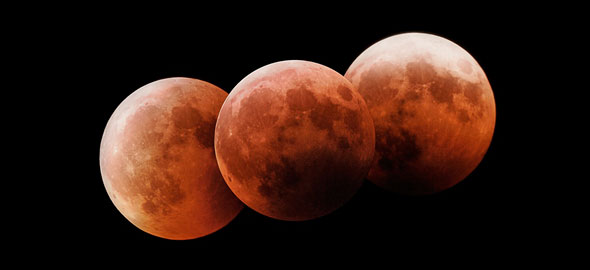|
||||
Lunar eclipse 2014
On April 15th, 2014 the moon will be eclipsed by the shadow of the earth. This marks the first of four eclipses occurring about 6 months part, called an eclipse tetrad. The last tetrad was a decade ago, and the next is not due until 2032.
The best eclipse visibility will be from North America and parts of South America. A team of GLORIA astronomers will celebrate this astronomical spectacle with a live broadcast from the city of Cuzco, Peru, in the Sacred Valley of the Incas. Throughout Europe, totality will not be visible. However the Canary Islands’ Teide volcano, at 3718m altitude on the island of Tenerife, offers an intriguing observational prospect. When a total lunar eclipse occurs close to sunrise or sunset at Teide, the shadow of the volcano aligns perfectly with the eclipsed moon. This unique phenomenon will be observable during the eclipse of April 15th and will be broadcast live.
Phenomenon
The earth’s umbral and penumbral shadows. Within the central umbral shadow, the moon receives no direct illumination from the sun. However, within the penumbral shadow, only part of the sunlight is blocked.
A lunar eclipse occurs when the moon passes directly into the shadow of the earth. This can occur only when the sun, earth and moon are exactly, or very closely, aligned, and the earth is between the sun and the moon. Hence, a lunar eclipse can only occur on the night of a full moon. Lunar eclipses can be seen from anywhere on the planet for which the moon is above the horizon at the time of eclipse. Unlike solar eclipses, where the timing of the eclipse phases depends on the geographical position of the observer, the times of lunar eclipses are the same regardless of the place of observation.
The event timing are as follows:
Start of Partiality – U1:
5:58 UT (0:58 Peru local time, 6:58 Canary Islands, 7:58 CEST)
Start of Totality – U2:
7:06 UT (2:06 Peru local time, 8:06 Canary Islands, 9:06 CEST)
Maximum of Totality:
7:45 UT (2:45 Peru local time, 8:45 Canary Islands, 9:45 CEST)
End of Totality – U3:
8:24 UT (3:24 Peru local time, 9:24 Canary Islands, 10:24 CEST)
End of Partiality – U4:
9:33 UT (4:33 Peru local time, 10:33 Canary Islands, 11:33 CEST)
Red moon
A team of GLORIA astronomers will broadcast live the event from the ancient Inca site of Saksaywaman, near the city of Cuzco, in Peru (see figure). At this site the totality duration will be approximately 1 hour 17 minutes. Expedition leader, Dr. Miquel Serra-Ricart, astronomers of IAC, Canary Islands, and Dr. Paul Cox (SLOOH project) will provide commentary of the live event in English and Spanish. The non-profit Shelios association (shelios.org) is responsible for the planning and logistics.
Broadcast
The total duration of the eclipse is 3h34m, with the totality lasting 1h 17m. However the live broadcasting from the observation places will be 55 minutes in total. There will be two live connections on April 15th :
Connection 1: with a total duration of 40 minutes at 6:30-7:10 UT (8:30 to 9:10 CEST). We’ll observer the sunrise from Tenerife (Teide’s shadow) and the start of the eclipse totality in Peru.
Connection 2: with a total duration of 15 minutes at 8:20-8:35 UT (10:20 to 10:35 CEST) to observer the end of total eclipse.
Note 1: The local time in Cusco site will be 5 hours behind UT (7 hours behind CEST). So in Peru it will be 1:30 at the start of the first connection.
Note 2: UT – Universal Time; CEST – Central European Saving Time. See here.
Additionally:
from April 15 at 5:50 UT (7:50 CEST) to 9:40 UT (11:40 CEST), every minute a live image of the Moon will be shown on the website (from partial phase to totality).
The broadcast can be followed on the GLORIA web portal live.gloria-project.eu. More information can be found here.
|
|
Share | Tweet |

|
||
|





